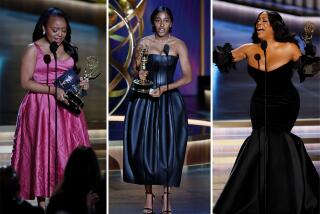77% of TV shows have no women creators. Here’s how that ripples across the industry
For the 2018-19 season, 96% of TV programs had no women directors of photography; 79% had no women directors; 77% had no women editors; and 77% had no women creators.
As a number of female-fronted TV shows, including “Veep” and “The Marvelous Mrs. Maisel,” vie for Emmys later this month, a study released Wednesday finds that “historic highs” for women in television still leave them vastly underrepresented in key behind-the-scenes roles.
Women composed 45% of all major characters in comedies, dramas and reality programs across TV (broadcast, cable and streaming platforms) in 2018-19 — an increase of 5 percentage points from the previous year, according to the annual “Boxed In” study conducted by San Diego State University’s Center for the Study of Women in Television and Film.
Meanwhile, women constituted 31% of all creators, writers, directors, executive producers, producers, editors and directors of photography, besting the previous high of 28% in 2016-17.
In the movie “Late Night,” which opened in limited release Friday, Mindy Kaling plays Molly Patel, a woman plucked from obscurity to help revitalize a long-running but creatively stagnant late-night show.
Now in its 22nd year, the study examines employment of women in front of and behind the camera on prime-time TV, while also surveying the depictions of women on screen and the racial breakdown of those depictions. The study tracked more than 5,100 characters and 5,000 behind-the-scenes credits from September 2018 through May 2019.
Martha Lauzen, executive director of the center, lauded the progress made but stressed that Hollywood’s gender gap is far from solved. She emphasized the importance of women serving in gatekeeping roles, such as creators and executive producers, in driving inclusion in front of and behind the camera.
For example, the study found that for programs with at least one female creator, women made up 49% of protagonists and 33% of directors. For programs with exclusively male creators, women accounted for 43% of protagonists and 23% of directors.
“Employing women in these roles boosts women’s representation in other behind-the-scenes roles, and the numbers of female characters on screen,” Lauzen said in a statement.
When examining race and ethnicity, the study found that 70% of female characters in speaking roles were white, up 3 percentage points from the previous year. However, the percentage of black females in speaking roles decreased 2 percentage points from last year to 17% in 2018-19; Latinas with speaking roles decreased 1 percentage point, to 6%. Asian females with speaking roles reached 7%, up a percentage point from the previous year.
The study also found that, overall, female characters skewed younger than males. The majority of female characters were in their 20s and 30s (56%), while the majority of male characters were in their 30s and 40s (59%).
President Trump calls Latinos “invaders.” Culture could offer a counter narrative—yet it does not.
More to Read
The complete guide to home viewing
Get Screen Gab for everything about the TV shows and streaming movies everyone’s talking about.
You may occasionally receive promotional content from the Los Angeles Times.








